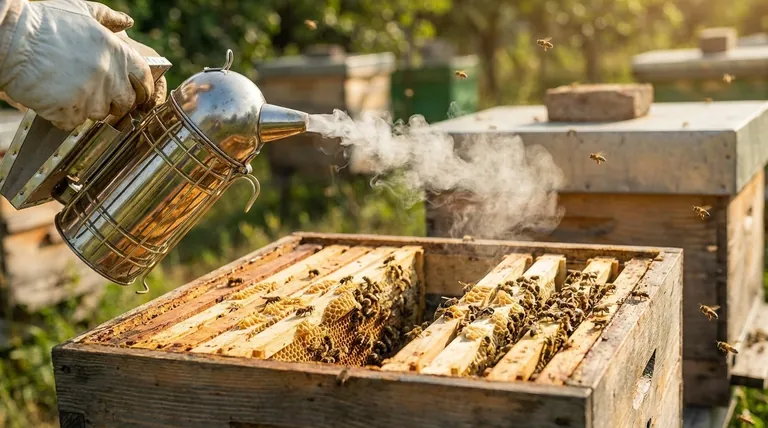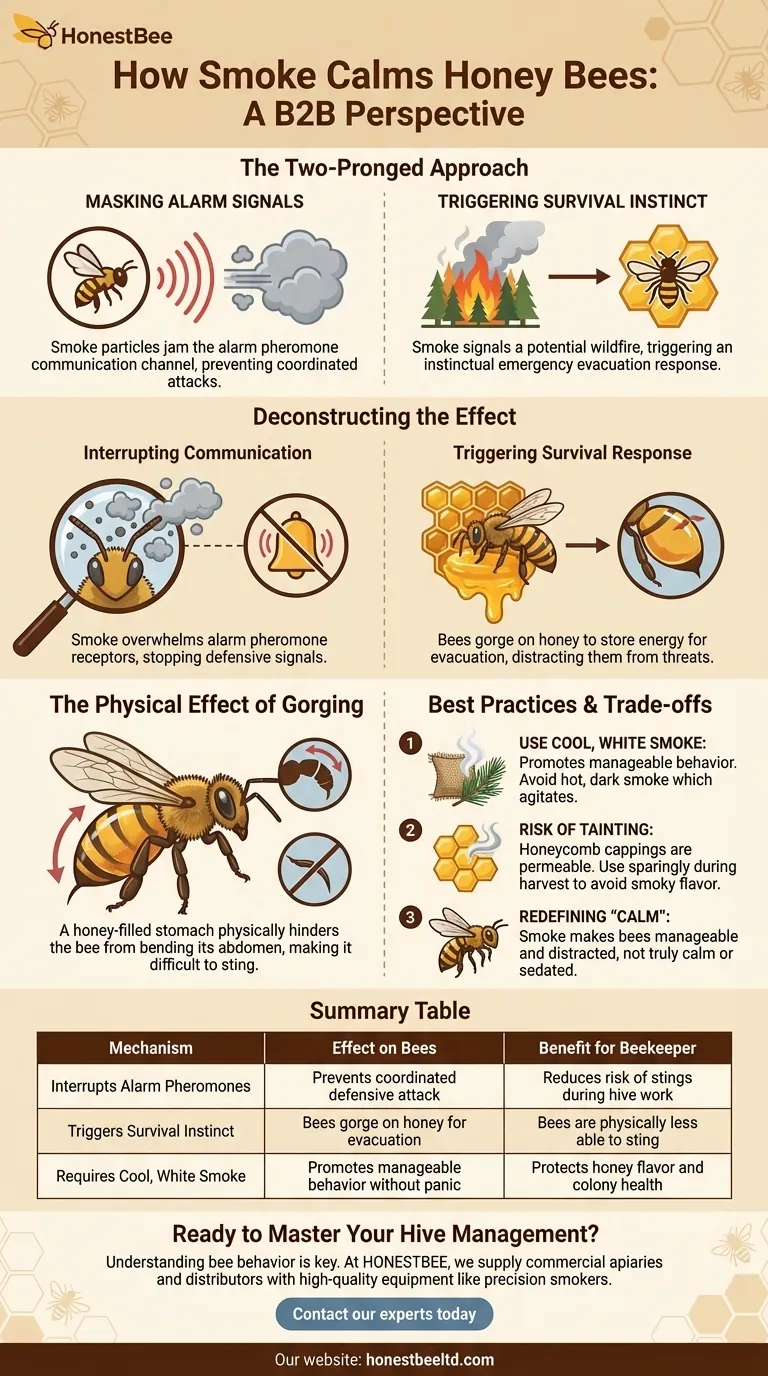At its core, smoke calms honey bees through a two-pronged approach that exploits their biology and instincts. It works primarily by masking the chemical alarm signals bees use to coordinate a defensive attack, while also triggering a primal survival response that distracts them from the perceived threat of a beekeeper.
The use of smoke is not about making bees sleepy or relaxed. It is a strategic manipulation of their communication and survival instincts, redirecting their focus from defending the hive to preparing for a potential evacuation.

Deconstructing the Calming Effect
To understand why smoke is such an effective tool, we must look at how it influences bee behavior on both a chemical and instinctual level. These two mechanisms work in tandem to create a manageable, non-defensive hive environment.
Interrupting Chemical Communication
When a guard bee perceives a threat, it releases an alarm pheromone. This chemical signal, which smells like bananas to humans, instantly alerts other bees in the colony, priming them for a coordinated defensive attack.
Smoke particles effectively "jam" this communication channel. The particles bind to the receptors on the bees' antennae, overwhelming their ability to detect the alarm pheromone. Without this signal, a widespread defensive response is never triggered.
Triggering a Primal Survival Instinct
For millions of years, smoke has signaled one primary danger to bees: a wildfire. The presence of smoke instinctively triggers an emergency evacuation response.
The bees' first priority becomes consuming as much honey as possible. They gorge themselves to store energy for the long journey to find and build a new home. This act of feeding serves the beekeeper's purpose perfectly.
The Physical Effect of Gorging
A bee that has filled its stomach with honey is physically less capable of stinging. Its abdomen becomes distended and less flexible, making it difficult for the bee to bend its body into the proper angle to effectively use its stinger.
This combination of being distracted by eating and physically hindered from stinging is what creates the "calm" state beekeepers rely on. The bees are not passive; they are simply preoccupied with a more urgent, instinctual task.
Understanding the Trade-offs and Best Practices
While smoke is a powerful tool, its application requires precision and an understanding of its potential downsides. Misuse can agitate the bees or damage the hive's products.
The Right Kind of Smoke Matters
Only cool, white smoke should be used. This type of smoke is produced from the slow, low-temperature combustion of natural materials like burlap, pine needles, or cotton.
Hot, dark smoke signals a fire that is dangerously close. This will not calm the bees but will instead agitate them, potentially making them more aggressive and causing them to flee the hive entirely.
Risk of Tainting the Honey
Honeycomb cappings are permeable and can absorb vapors and flavors from the air. While a few gentle puffs of smoke are unlikely to cause issues, excessive smoking can taint the honey.
Studies show that heavy smoke exposure can alter the volatile characteristics of honey, imparting a smoky flavor that ruins the final product. A light touch is always the best approach.
Redefining "Calm"
It is critical to understand that smoke makes bees manageable, not truly calm. The bees are moving away from the smoke in an agitated but non-defensive state, focused on survival.
The goal is not to fill the hive with smoke, but to use just enough to break the initial chain of alarm communication and encourage the feeding response.
Making the Right Choice for Your Goal
Using smoke effectively means tailoring its application to the specific task at hand. Your goal should dictate how much smoke you use and when you apply it.
- If your primary focus is a routine inspection: Use minimal, cool smoke at the entrance and under the lid to mask initial alarm pheromones without causing undue stress.
- If your primary focus is managing an aggressive hive: A bit more smoke may be needed to ensure the gorging response is fully triggered, but be mindful of overheating the hive.
- If your primary focus is harvesting honey: Be extremely judicious with smoke, as this is when the risk of tainting the honey is highest. Use it sparingly and only when necessary to control defensiveness.
Ultimately, smoke is a tool for redirecting a bee's attention, not for sedation.
Summary Table:
| Mechanism | Effect on Bees | Benefit for Beekeeper |
|---|---|---|
| Interrupts Alarm Pheromones | Prevents coordinated defensive attack | Reduces risk of stings during hive work |
| Triggers Survival Instinct | Bees gorge on honey for potential evacuation | Bees are physically less able to sting |
| Requires Cool, White Smoke | Promotes manageable behavior without panic | Protects honey flavor and colony health |
Ready to Master Your Hive Management?
Understanding bee behavior is key to successful beekeeping. At HONESTBEE, we supply commercial apiaries and distributors with the high-quality, reliable equipment needed to apply these techniques effectively—from precision smokers to essential hive tools.
Contact our experts today to discuss how our wholesale-focused solutions can support your operation's safety and efficiency.
Visual Guide

Related Products
- European Stainless Steel Bee Smoker for Honey Bee Hive
- Premium Traditional Copper Bee Smoker with Bellows
- Professional Bee Smoker with Elongated Spout and Durable Bellows for Beekeeping
- Heavy-Duty Bee Smoker with Durable Plastic Bellows for Beekeeping
- Heavy Duty Manual Bee Smoker Blower for Beekeeping
People Also Ask
- What are the differences between stainless steel and galvanized steel bee smokers? Choose the Right Smoker for Your Apiary
- What are the benefits of cleaning a bee smoker? Ensure Hive Safety and Bee Health
- Can you use too much smoke on bees? The Right Way to Use a Bee Smoker for Calm Inspections
- What are the steps to operate a bee smoker? Master the Art of Gentle Beehive Management
- What are the features of a recommended bee smoker? A Guide to Safety, Durability & Performance



















